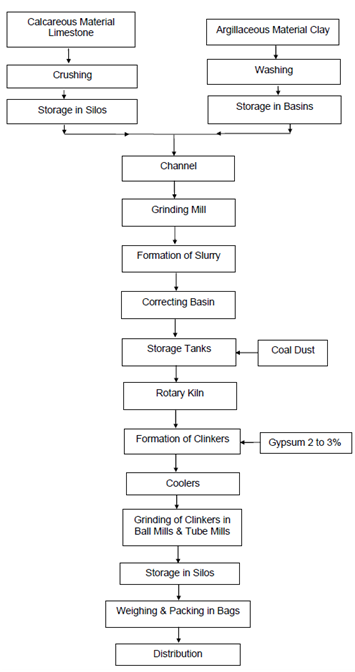Flow Diagram of Wet Process:
The hot gases or flames are forced through the lower end of the kiln. The portion of the kiln near its upper end is known as dry zone and in this zone; the water of slurry is evaporated. As the slurry gradually descends, there is rise in temperature and in the next section of kiln; the carbon dioxide from slurry is evaporated. The small lumps, called as nodules, are formed at this stage. Those nodules then gradually roll down passing by zones of rising temperature and ultimately reach to the burning zone, whereas temperature is about 1500°C. In burning zone, the calcined product is formed and nodules are converted into small hard dark greenish blue balls that are known as clinkers. The size of clinkers varies from 3 mm to 20 mm and they are very hot when they come out of burning zone of kiln. The temperature of clinker at the outlet of kiln is nearly 1000°C. The clinker drops into a rotary cooler where it is cooled under controlled conditions.

Figure: Flow Diagram of Wet Process
The clinkers as obtained from the rotary kiln are finely grounded in ball mills and tube mills. During grinding a small quantity, about 2 to 3% of gypsum is added. If gypsum is not added, the cement would set as soon as water is added. The gypsum controls the initial setting time of cement. The gypsum acts as a retarder and delays the setting action of cement. Thus, gypsum permits cement to be mixed with the aggregates and to be placed in position.
A ball mill consists of several compartments charged with progressively smaller hardened steel balls. A particles crushed to the needed fineness are separated through currents of air and taken to storage silos from where the cement is bagged or filled into barrels for bulk supply to bridges, dams or other large work sites.